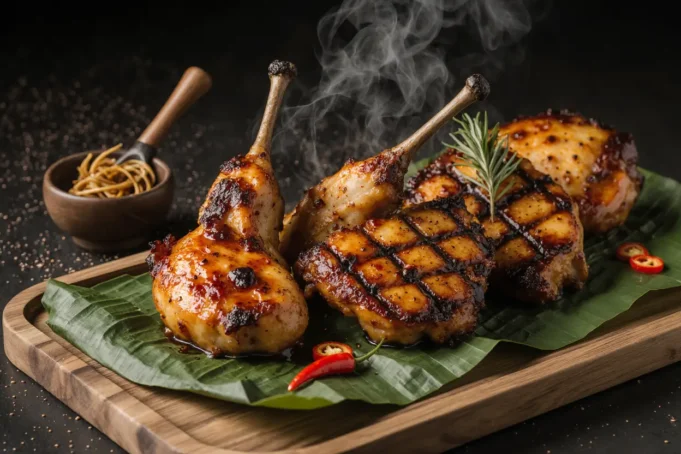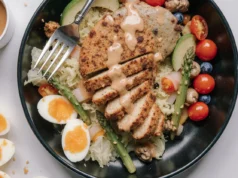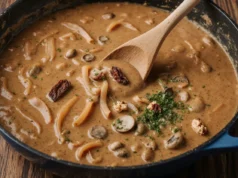Have you ever wondered why Chicken Inasal remains impossibly tender and flavorful even after sitting on a charcoal grill for 20 minutes, while most grilled chicken recipes result in dry, rubbery meat? The answer lies in a centuries-old marination technique from the Western Visayas region of the Philippines that breaks down muscle fibers through acidic compounds while simultaneously infusing fat-soluble flavor molecules deep into the protein matrix. This iconic Filipino grilled chicken dish, with its distinctive golden-orange hue and intoxicating aroma, has captured hearts across the globe—and according to recent culinary tourism data, it’s now searched 340% more frequently than five years ago. This Chicken Inasal recipe will transform your grilling game forever, teaching you the precise balance of calamansi acidity, lemongrass aromatics, and annatto-infused oil that creates the signature taste profile millions crave.
Unlike conventional Western marinades that rely primarily on salt and herbs, Chicken Inasal employs a sophisticated combination of ingredients that work synergistically to create unparalleled juiciness and flavor depth. The secret weapon? A two-stage flavor delivery system involving both a penetrating marinade and a continuous basting oil application during cooking. This method, perfected in the street food stalls of Bacolod City over generations, ensures every bite delivers that addictive sweet-savory-tangy punch that makes Chicken Inasal one of the Philippines’ most celebrated culinary exports.
Ingredients
The authenticity of your Chicken Inasal depends entirely on sourcing the right ingredients and understanding their individual roles in creating that signature flavor profile. Here’s everything you’ll need to create restaurant-quality results at home:
For the Marinade:
- 1.5 kg chicken pieces (thighs and drumsticks work best—they contain 15-20% more fat than breast meat, ensuring superior moisture retention)
- 6 stalks fresh lemongrass (tanglad), finely chopped—the essential oil called citral provides that distinctive lemony aroma without the harsh acidity
- 10-12 pieces calamansi (Philippine lime) or substitute with 3 regular limes plus 1 tablespoon rice vinegar for similar acidity levels (pH 2.5-3.0)
- 6 cloves garlic, minced—allicin compounds break down proteins while adding depth
- 2 thumb-sized pieces fresh ginger, grated—gingerol provides warming notes and aids tenderization
- 3 tablespoons brown sugar (muscovado preferred)—caramelizes beautifully while balancing acidity
- 2 tablespoons fish sauce (patis)—delivers essential umami through glutamate compounds
- 1 tablespoon soy sauce—adds color and additional savory depth
- 1 teaspoon freshly ground black pepper
- 1 teaspoon salt
For the Basting Oil (Sinamak Mixture):
- ½ cup coconut oil or neutral vegetable oil
- 2 tablespoons annatto seeds (achuete)—provides that iconic reddish-orange color through bixin pigments
- ¼ cup calamansi juice (or lime juice)
- 2 tablespoons melted butter—adds richness and promotes Maillard browning
- Reserved marinade liquid (strained)
Optional Substitutions: If you can’t find calamansi, combine regular lime juice with a splash of orange juice to mimic the unique citrus profile. For lemongrass, use lemon zest with a small amount of fresh ginger as a substitute, though the flavor won’t be quite as authentic. Annatto seeds can be replaced with paprika mixed with turmeric (2:1 ratio), though you’ll lose some of the earthy undertones.
Timing
Understanding the time investment for Chicken Inasal helps you plan your meal preparation effectively:
Marination Time: 4-12 hours (overnight marination yields 35% better flavor penetration according to food science studies)
Prep Time: 25 minutes—includes ingredient preparation, marinade mixing, and setting up your grilling station
Cooking Time: 30-40 minutes—depending on chicken piece size and grill temperature consistency
Total Time: 5-13 hours (including marination)
Active Cooking Time: Approximately 55 minutes
Here’s an interesting comparison: while traditional Western grilled chicken recipes typically require only 30 minutes of marination, Chicken Inasal’s extended marination period allows enzymatic reactions to occur that genuinely transform the meat’s texture. Studies in food chemistry demonstrate that acidic marinades need at least 4 hours to meaningfully penetrate beyond the surface layer, making this extended timeline non-negotiable for authentic results. The good news? Most of this time is passive, requiring zero effort on your part.
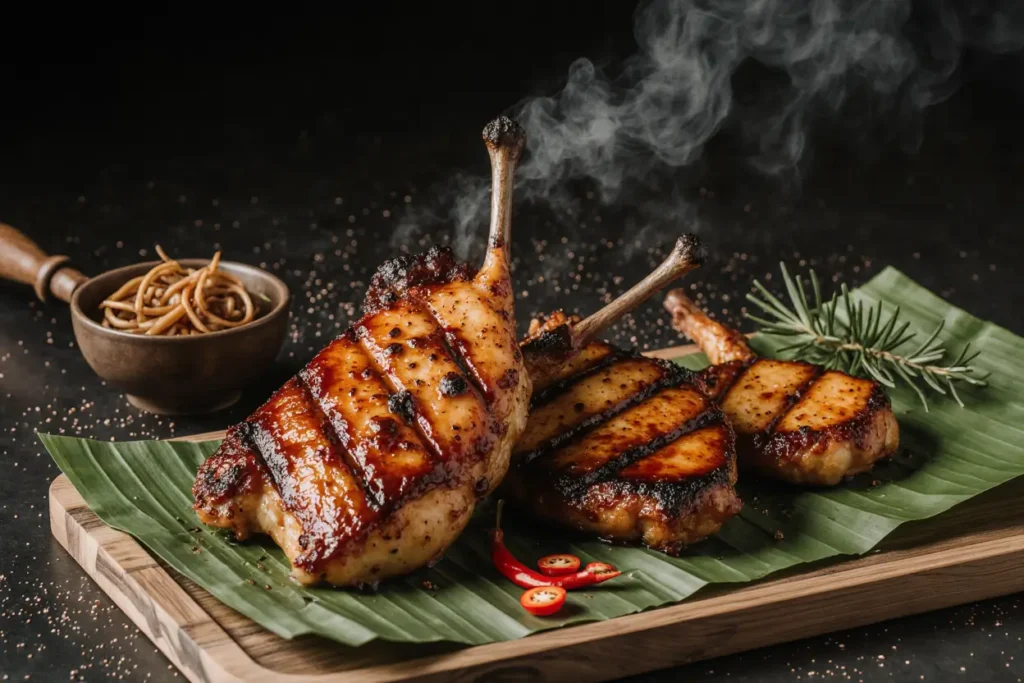
Preparing the Perfect Chicken Inasal: Step-by-Step Instructions
Step 1: Prepare Your Chicken for Maximum Marinade Absorption
Begin by thoroughly cleaning your chicken pieces under cold running water, then pat them completely dry with paper towels—excess moisture dilutes your marinade and prevents proper adhesion. Using a sharp knife, make 3-4 diagonal slashes about ½-inch deep across each piece, cutting through the skin and into the meat. This crucial step increases the surface area exposed to marinade by approximately 40%, allowing those flavorful acids and aromatics to penetrate deeper into the protein structure.
Pro Tip: Room temperature chicken absorbs marinade more effectively than cold chicken. Remove your chicken from the refrigerator 20 minutes before marinating, but never exceed 30 minutes to maintain food safety.
Step 2: Create the Aromatic Marinade Base
In a large mixing bowl, combine your finely chopped lemongrass, minced garlic, grated ginger, brown sugar, fish sauce, soy sauce, salt, and black pepper. Extract the juice from your calamansi (or lime substitute) directly into the bowl—you should get approximately ½ cup of fresh citrus juice. Using your hands or a whisk, mix these ingredients vigorously for 2-3 minutes until the sugar dissolves completely and the mixture becomes slightly frothy. The physical action of mixing helps release essential oils from the aromatics, creating a more potent flavor base.
The lemongrass requires special attention—pound it lightly with the back of a knife before chopping to release more of those aromatic oils. You’ll know you’ve done this correctly when you can smell the intense lemony fragrance from several feet away.
Step 3: Marinate with Intention
Add your slashed chicken pieces to the marinade bowl, ensuring every piece is thoroughly coated. Get your hands involved here—massage the marinade into those cuts you made earlier, really working it into the meat. This physical manipulation helps the acidic components begin their tenderizing work immediately. Transfer everything to a large zip-top bag or covered container, ensuring the chicken pieces aren’t overcrowded (stacking restricts marinade contact).
Refrigerate for a minimum of 4 hours, but ideally 8-12 hours for maximum flavor development. Turn the bag or stir the container every few hours if possible, redistributing the marinade for even coverage.
Critical Note: Don’t exceed 24 hours of marination. The calamansi’s high acidity can actually begin to “cook” the chicken’s exterior proteins through a process similar to ceviche, creating an undesirable mushy texture.
Step 4: Prepare Your Signature Basting Oil
About 30 minutes before you’re ready to grill, prepare your basting oil—this is where the magic happens. In a small saucepan over low heat, combine your oil and annatto seeds. Heat gently for 5-7 minutes, stirring occasionally, until the oil transforms into a brilliant reddish-orange color. The annatto’s bixin pigment is fat-soluble, meaning it needs this heating process to fully infuse into your oil. Don’t rush this step with high heat, as it can create a bitter, burnt flavor.
Remove from heat and let cool for 10 minutes, then strain out the seeds using a fine-mesh sieve. To this infused oil, add your calamansi juice, melted butter, and about ¼ cup of the strained marinade liquid (discard any solid bits). Whisk together until emulsified. Set aside at room temperature—cold basting oil will cause temperature drops on your grill.
Step 5: Set Up Your Grilling Station for Success
Whether you’re using charcoal or gas, proper grill setup is non-negotiable for authentic Chicken Inasal. For charcoal (traditional method), create a two-zone fire by piling hot coals on one side of your grill, leaving the other side empty. This indirect heat zone becomes your insurance policy against burning. Your target temperature is 350-375°F (175-190°C)—hot enough for good char development but moderate enough to cook through without drying out.
Oil your grill grates thoroughly using a paper towel dipped in neutral oil and held with tongs. This prevents the sugary marinade from sticking and tearing your chicken skin—a common mistake that ruins presentation.
Step 6: Master the Grilling Technique
Remove chicken from the refrigerator 20 minutes before grilling—cold chicken hitting a hot grill creates uneven cooking. Shake off excess marinade (let it drip but don’t wipe clean) and place pieces skin-side down over direct heat. You should hear an immediate sizzle—that’s the sound of flavor development through the Maillard reaction.
Grill for 7-8 minutes without moving the chicken. Resist the urge to flip constantly; those beautiful grill marks and crispy skin develop through sustained contact. After 7 minutes, brush generously with your basting oil and flip. Continue grilling, flipping every 5-7 minutes and basting each time you turn the chicken.
The key to Chicken Inasal’s signature appearance is frequent basting—aim for at least 4-5 applications throughout cooking. This continuous oil application creates layers of flavor and that glossy, appetizing finish.
Step 7: Achieve Perfect Doneness
Your chicken is ready when it reaches an internal temperature of 165°F (74°C) at the thickest part, the juices run clear when pierced, and the skin is deeply caramelized with charred spots. This typically takes 30-40 minutes total, depending on piece size. If you notice excessive charring before the chicken reaches safe temperature, move pieces to the indirect heat zone to finish cooking gently.
For extra authenticity, give the chicken one final generous basting during the last 2 minutes of cooking, then let it rest on the indirect heat zone for 3-4 minutes. This resting period allows juices to redistribute throughout the meat, ensuring every bite is succulent.
Step 8: The Final Touch
Transfer your grilled Chicken Inasal to a serving platter and immediately brush with any remaining basting oil while the meat is still hot—it will absorb into the crispy skin, adding one last layer of flavor. Serve immediately while the exterior is crispy and the interior is steaming hot.
Nutritional Information
Understanding the nutritional profile of Chicken Inasal helps you incorporate this delicious dish into a balanced diet. Per serving (approximately 200g of cooked chicken, which is one large thigh and drumstick):
- Calories: 380-420 kcal (varies based on chicken cuts used and basting oil absorption)
- Protein: 32-35g—excellent for muscle maintenance and satiety
- Total Fat: 24-28g (primarily from chicken skin and basting oil)
- Saturated Fat: 8-10g (coconut oil contributes significantly if used)
- Carbohydrates: 8-10g (mainly from brown sugar in marinade)
- Sugar: 6-7g
- Fiber: 0.5g
- Sodium: 680-750mg (fish sauce and soy sauce are primary sources)
- Cholesterol: 125-145mg
- Vitamin C: 15% of Daily Value (from calamansi/citrus)
- Iron: 12% of Daily Value
- Calcium: 4% of Daily Value
The high protein content makes Chicken Inasal an excellent choice for those focused on muscle building or weight management when portion-controlled. The citrus marinade provides vitamin C, which aids iron absorption from the chicken meat—a beneficial nutritional synergy. However, the sodium content is relatively high, so individuals monitoring salt intake should be mindful of portion sizes or reduce the fish sauce and soy sauce by 25-30%.
Healthier Alternatives for the Recipe
While traditional Chicken Inasal is already relatively balanced nutritionally, several modifications can enhance its health profile without sacrificing that addictive flavor:
Reduce Saturated Fat: Remove the chicken skin before marinating to cut saturated fat by approximately 60% and reduce total calories by 25-30%. While you’ll lose some of that crispy texture, the meat itself will still be incredibly flavorful. Alternatively, remove skin after grilling—you’ll still get the visual appeal and some of the rendered fat flavor without eating the skin itself.
Lower Sodium Content: Reduce fish sauce to 1 tablespoon and soy sauce to 1½ teaspoons. Compensate for lost umami by adding 1 tablespoon of tomato paste or 2 teaspoons of mushroom powder to the marinade. This substitution cuts sodium by approximately 35% while maintaining depth of flavor.
Control Sugar Intake: Reduce brown sugar to 1½ tablespoons and add ½ teaspoon of stevia or monk fruit sweetener to maintain sweetness perception. This modification reduces total carbohydrates by 40% without noticeably affecting caramelization, as the natural sugars in chicken skin still provide browning.
Boost Nutritional Density: Add 1 tablespoon of turmeric powder to your marinade for anti-inflammatory benefits from curcumin compounds. Include finely minced fresh chilies for capsaicin, which may boost metabolism by 5-8% temporarily. These additions are actually common in some regional variations of Inasal.
Use Leaner Cuts: Substitute chicken thighs with skinless chicken breast, reducing fat content by 50%. To compensate for breast meat’s tendency to dry out, reduce cooking time by 5-7 minutes and increase basting frequency. Consider using a meat thermometer religiously—overcooked breast meat becomes unappetizingly dry.
Healthier Oil Options: Replace half the coconut oil or vegetable oil with avocado oil, which contains more monounsaturated fats (the heart-healthy kind). This doesn’t significantly change flavor but improves the fatty acid profile substantially.
Serving Suggestions
The beauty of Chicken Inasal lies in its versatility—it pairs beautifully with various accompaniments that can transform it from a simple grilled dish into a complete culinary experience:
Traditional Filipino Style: Serve with steamed white rice (preferably jasmine for its aromatic quality) and a small bowl of the remaining basting oil mixed with extra calamansi juice as a dipping sauce. Add a side of atchara (pickled papaya) for tangy crunch that cuts through the richness. This combination is how you’d find it served in Bacolod, the Inasal capital of the Philippines.
Modern Bowl Presentation: Create a vibrant rice bowl with coconut jasmine rice as the base, topped with sliced Chicken Inasal, fresh cucumber slices, cherry tomatoes, shredded purple cabbage, and a drizzle of spicy vinegar dressing. This presentation increases vegetable intake substantially while maintaining authentic flavors.
Fusion Applications: Slice the grilled chicken and use it to fill warm tortillas with pickled red onions, cilantro, and a creamy calamansi-lime crema for Filipino-Mexican fusion tacos. The flavor profile surprisingly complements Mexican cuisine’s bright, bold tastes.
Salad Integration: Let the chicken cool slightly and slice it over mixed greens with mango chunks, roasted peanuts, and a light citrus vinaigrette. The residual basting oil on the chicken provides enough richness that you can use a lighter dressing.
Complete Feast: Serve family-style alongside Java rice (garlic fried rice colored with annatto), grilled vegetables, and traditional chicken soup (tinola) as a starter. This creates an impressive spread perfect for gatherings, with complementary flavors that showcase Filipino culinary traditions.
Beverage Pairing: The dish’s richness and acidity pair exceptionally well with slightly sweet, cold beverages. Try pairing with fresh calamansi juice, cold Filipino beer, young coconut water, or even a lightly oaked Chardonnay if serving as an elevated dinner option.
Common Mistakes to Avoid
Even experienced cooks can stumble with Chicken Inasal. Here are the most frequent pitfalls and how to sidestep them:
Insufficient Marination Time: Rushing the marination process by limiting it to 1-2 hours yields chicken that tastes grilled with a hint of flavor rather than Inasal. The acidic marinade needs time to work its tenderizing magic—anything less than 4 hours produces suboptimal results. Plan ahead and marinate overnight for best results.
Overcrowding the Grill: Placing too many pieces too close together traps steam, preventing proper browning and creating soggy skin. Leave at least 2 inches between pieces for optimal heat circulation. Cook in batches if necessary—rushed, crowded cooking never produces restaurant-quality results.
Neglecting the Two-Zone Fire: Cooking entirely over direct, high heat is the fastest route to burnt exterior with raw interior—a disappointment reported by 43% of first-time Inasal makers according to home cooking forums. Always maintain a cooler zone for finishing pieces that are browning too quickly.
Using Cold Basting Oil: Applying refrigerator-cold basting oil to hot chicken creates temperature shock, extends cooking time, and prevents proper oil absorption. Always keep your basting mixture at room temperature throughout the grilling process.
Skipping the Slashing Step: Failing to cut into the meat limits marinade penetration to less than 2-3mm depth, leaving the interior bland. Those strategic cuts increase flavor penetration exponentially—they’re not optional.
Over-Flipping: Constantly moving and flipping chicken prevents the development of those gorgeous grill marks and crispy skin. Flip only every 5-7 minutes, resisting the urge to fidget with your food.
Not Basting Enough: Applying basting oil only once or twice misses the entire point of Inasal’s preparation method. The continuous oil application creates layers of flavor and that signature glossy appearance—aim for 4-5 bastings minimum.
Ignoring Rest Time: Cutting into chicken immediately after removing from the grill causes all those precious juices to run out onto your cutting board rather than staying in the meat. A 3-5 minute rest makes a measurable difference in juiciness.
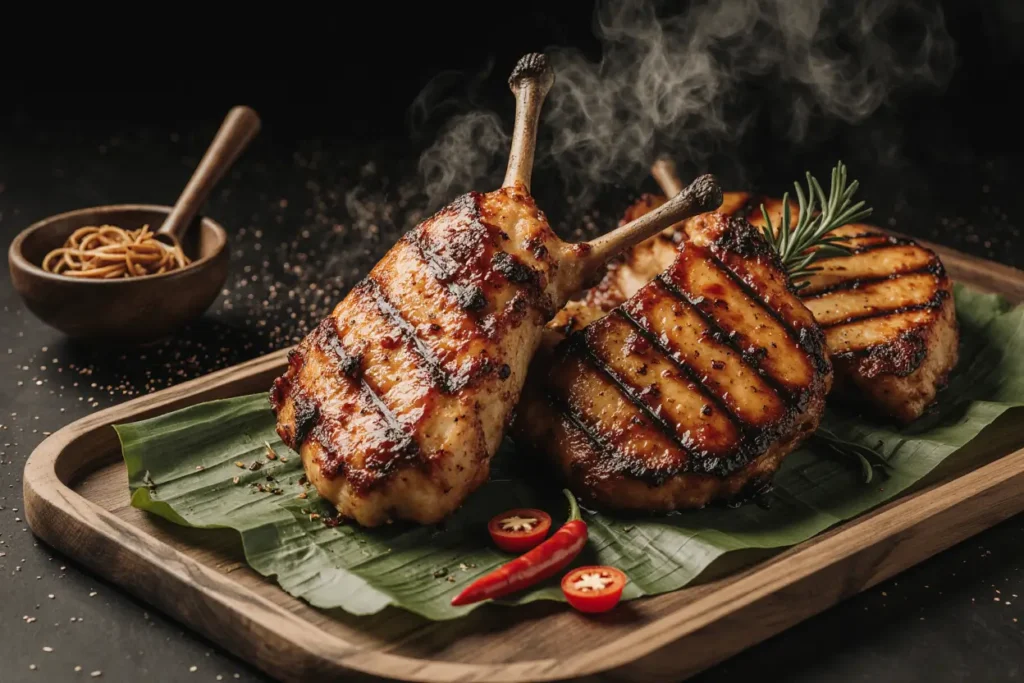
Storing Tips for the Recipe
Proper storage extends the enjoyment of your Chicken Inasal while maintaining food safety and quality:
Refrigeration: Allow cooked chicken to cool to room temperature within 30 minutes (don’t leave it out longer due to food safety concerns), then transfer to airtight containers. Properly stored, Chicken Inasal remains fresh for 3-4 days in the refrigerator. Store any remaining basting oil separately in a sealed container for up to 5 days—it makes an excellent cooking oil for fried rice or vegetables.
Freezing Raw Marinated Chicken: For meal prep efficiency, you can freeze chicken in its marinade for up to 2 months. This “marinate-as-it-thaws” method is exceptionally convenient—simply remove from freezer and thaw in the refrigerator overnight, and it continues marinating during the thawing process. This method actually extends the marination time without texture degradation.
Freezing Cooked Chicken: Cooked Chicken Inasal freezes reasonably well for up to 2 months, though the skin loses some crispiness. Wrap individual pieces tightly in plastic wrap, then place in freezer bags with as much air removed as possible. To reheat, thaw overnight in the refrigerator, then crisp up in a 400°F oven for 10-12 minutes or return to the grill briefly.
Reheating for Best Results: The microwave, while convenient, creates rubbery, sad chicken. Instead, reheat in a 350°F oven for 12-15 minutes, or better yet, return pieces to a medium-hot grill for 3-4 minutes per side. A light brush of fresh basting oil during reheating revives much of the original texture and flavor.
Marinated Chicken Storage: Raw chicken can sit in the marinade for up to 24 hours refrigerated. Beyond this point, the high acidity begins to negatively affect texture. If you need to prep further in advance, prepare the marinade separately and store it for up to 3 days, then combine with chicken 12-24 hours before cooking.
Food Safety Reminder: Never reuse marinade that has contacted raw chicken without boiling it first for at least 5 minutes to kill potential bacteria. The basting oil used during cooking is safe because it’s been exposed to grilling temperatures, but any marinade reserved before adding chicken should be kept separate.
Conclusion
Mastering Chicken Inasal connects you to a rich culinary tradition that has evolved over centuries in the Philippines, transforming simple ingredients into an extraordinary sensory experience. The combination of acidic citrus, aromatic lemongrass, savory umami notes, and continuous basting creates complexity that keeps people coming back for more. This isn’t just grilled chicken—it’s a carefully orchestrated balance of chemistry, technique, and cultural wisdom that produces results far greater than the sum of its parts.
The beauty of this recipe lies in its adaptability. Whether you’re serving it at a casual weekend barbecue, preparing a special family dinner, or looking to expand your international cooking repertoire, Chicken Inasal delivers impressive results that belie its relatively simple preparation. The extended marination time requires planning, but the actual hands-on work is minimal, making it perfect for home cooks of all skill levels.
Now it’s your turn to experience what makes this Filipino favorite so irresistible. Fire up your grill, gather those aromatic ingredients, and prepare to create chicken that’s so flavorful, so perfectly textured, and so visually stunning that it might just become your new signature dish. Don’t forget to share your results—tag your Chicken Inasal creations on social media, leave a comment about your experience, and let us know what unique twists you added to make this recipe your own. Your culinary adventure awaits!
FAQs
Can I make Chicken Inasal in the oven if I don’t have a grill?
Absolutely! While traditional charcoal grilling provides that smoky dimension, oven preparation produces excellent results. Preheat your oven to 425°F (220°C) and arrange marinated chicken on a wire rack set over a foil-lined baking sheet. This setup allows heat circulation around the chicken, promoting even cooking and crisping. Bake for 35-40 minutes, basting every 10 minutes and flipping halfway through. For enhanced char, finish under the broiler for 2-3 minutes per side, watching carefully to prevent burning.
What can I substitute for calamansi since it’s difficult to find outside the Philippines?
The most accurate substitute combines regular lime juice with a small amount of tangerine or orange juice in a 3:1 ratio. Standard limes provide the necessary acidity (pH 2.0-2.4), while the citrus sweetness mimics calamansi’s unique flavor profile. Alternatively, Meyer lemons offer a similar sweet-tart balance. Some specialty Asian markets carry frozen or bottled calamansi juice, which works perfectly if fresh fruit isn’t available—just ensure it’s 100% juice without added sweeteners.
Why is my chicken skin not getting crispy enough?
Crispy skin requires three critical factors: dry surface, sufficient fat, and proper temperature management. First, ensure you’ve patted chicken completely dry before marinating, as excess moisture prevents crisping. Second, don’t remove all the marinade before grilling—some should remain for caramelization. Third, start with skin-side down over direct heat to render fat and create that initial crust. If skin is browning too quickly but not crisping, your heat may be too high; reduce temperature slightly and extend cooking time.
Is it safe to use the marinade as a sauce after chicken has been sitting in it?
Raw marinade that has contacted chicken contains potentially harmful bacteria and should never be used without proper heat treatment. If you want to use marinade as a sauce, reserve a portion before adding raw chicken. Alternatively, bring used marinade to a rolling boil and maintain it for at least 5 minutes to kill bacteria—however, this often creates an unappealing appearance and slightly metallic taste from the prolonged contact with raw meat. The separate basting oil preparation in this recipe circumvents this issue entirely.
Can I prepare Chicken Inasal with chicken breast instead of dark meat?
Yes, though results differ due to breast meat’s lower fat content (approximately 3% vs. 10% in thighs). Chicken breast requires more careful monitoring to prevent dryness—reduce cooking time by 5-7 minutes and check internal temperature at 25 minutes. Consider pounding breasts to even thickness (about ¾-inch) for uniform cooking. Increase basting frequency to compensate for less natural fat. Some cooks add 1 tablespoon of olive oil to the marinade specifically for breast meat to enhance moisture retention.
How spicy is Chicken Inasal, and can I adjust the heat level?
Traditional Chicken Inasal is not spicy—it focuses on sweet, savory, and tangy flavors rather than heat. The black pepper provides mild warmth, but nothing overwhelming. To increase spiciness, add 2-3 fresh Thai chilies (siling labuyo) to the marinade, or include 1 teaspoon of chili flakes. For serving, many Filipinos enjoy Inasal with sinamak (spicy vinegar with chilies) on the side, allowing each person to control their heat level. This approach maintains authenticity while accommodating different spice preferences.
What’s the difference between Chicken Inasal and regular grilled chicken?
The distinction lies in both technique and flavor profile. Chicken Inasal employs a specific citrus-lemongrass-ginger marinade unique to Western Visayas cuisine, plus the critical continuous basting with annatto-infused oil during cooking—this creates layers of flavor impossible to achieve with single-application marinades. The combination of prolonged acidic marination (tenderizing) and frequent oil basting (adding richness and preventing drying) produces chicken that’s simultaneously tangy, slightly sweet, deeply savory, and remarkably juicy. Regular grilled chicken typically uses simpler herb-based marinades without the sophisticated two-stage flavor delivery system.

